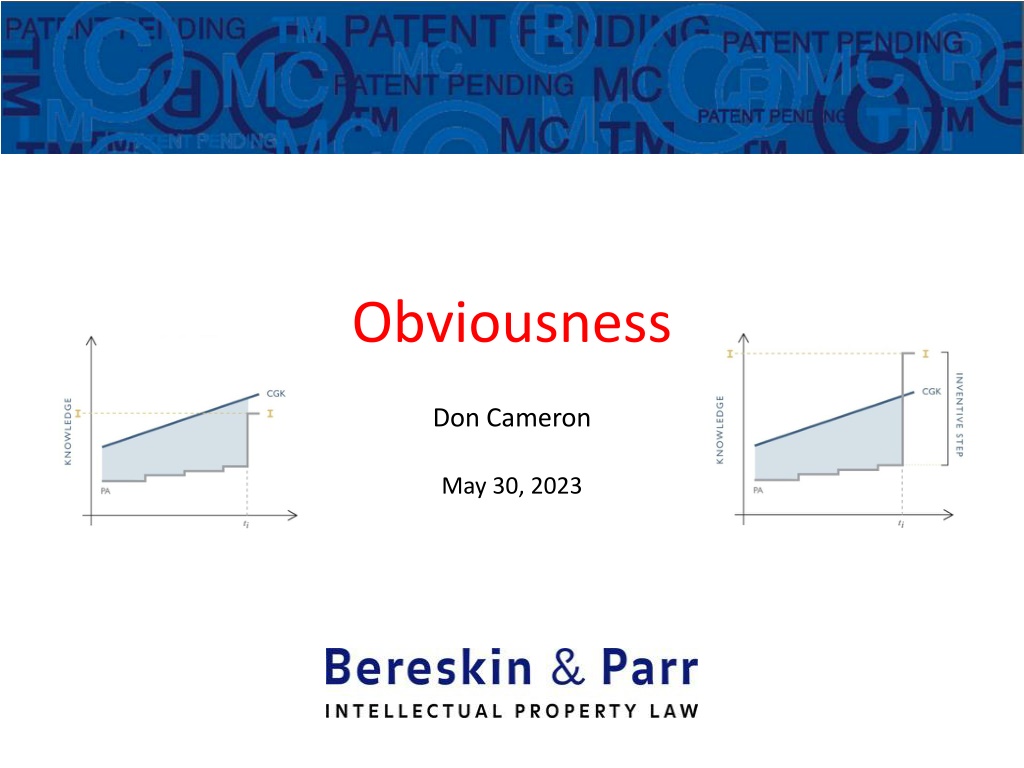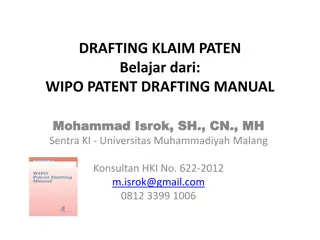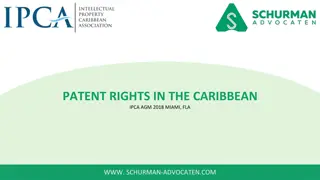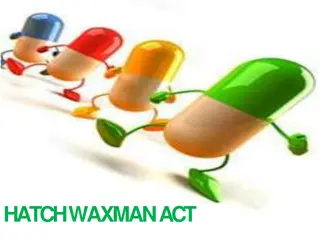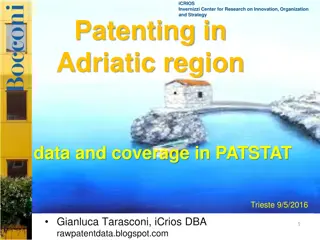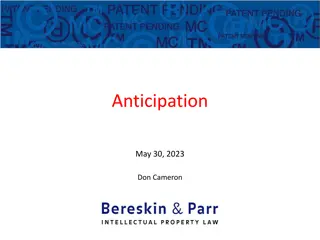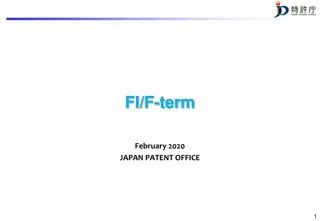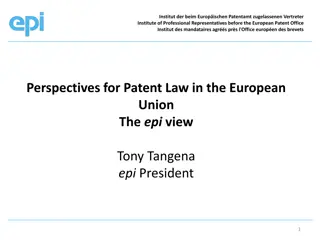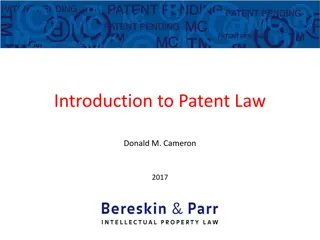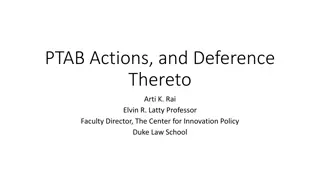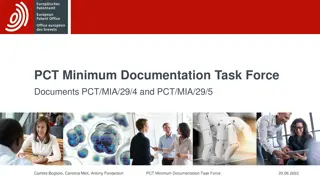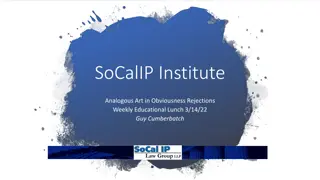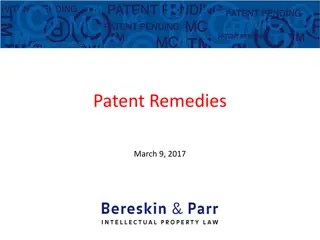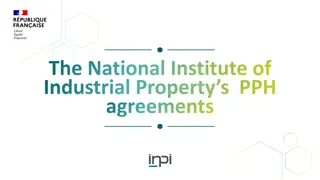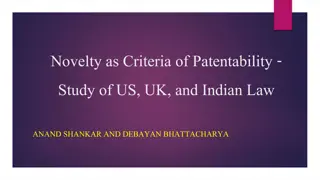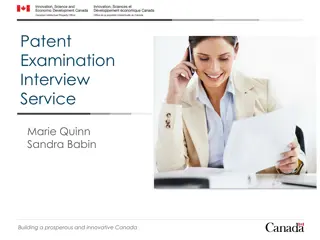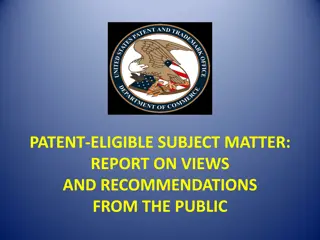Understanding Obviousness in Patent Law
Exploring the concept of obviousness in patent law, this content delves into the criteria for determining whether an invention would have been obvious to a person skilled in the art. It discusses the importance of clear and precise patent claims, the boundaries of inventive steps, and the role of prior art and common general knowledge in patent applications. The content also provides insights into increasing production efficiency and staking a claim in the field of intellectual property.
Download Presentation

Please find below an Image/Link to download the presentation.
The content on the website is provided AS IS for your information and personal use only. It may not be sold, licensed, or shared on other websites without obtaining consent from the author. Download presentation by click this link. If you encounter any issues during the download, it is possible that the publisher has removed the file from their server.
E N D
Presentation Transcript
Obviousness Don Cameron May 30, 2023 Donald M. Cameron
Would any idiot have thought of that? Beloit Canada Ltd. v. Valmet Oy (1986), 8 C.P.R. (3d) 289 (F.C.A. per Hugessen J.A.) at p. 294: The classical touchstone for obviousness is the technician skilled in the art but having no scintilla of inventiveness or imagination; a paragon of deduction and dexterity, wholly devoid of intuition; a triumph of the left hemisphere over the right. The question to be asked is whether this mythical creature (the man in the Clapman omnibus of patent law) would, in the light of the state of the art and common general knowledge as at the claimed date of invention, have come directly and without difficulty to the solution taught by the patent. It is a very difficult test to satisfy.
How to increase production 25% Gelatin capsules Four fingers ------ 5 fingers
Staking a Claim "By his claims the inventor puts fences around the fields of his monopoly and warns the public against trespassing on his property. His fences must be clearly placed in order to give the necessary warning and he must not fence in any property that is not his own. The terms of a claim must be free from avoidable ambiguity or obscurity and must not be flexible; they must be clear and precise so that the public will be able to know not only where it must not trespass by where it may safely go. If a claim does not satisfy these requirements it cannot stand... The inventor may make his claims as narrow as he pleases within the limits of his invention but he must not make them too broad. He must not claim what he has not invented for thereby he would be fencing off property which does not belong to him. It follows that a claim must fail if, in addition to claiming what is new and useful, it also claims something that is old or something that is useless. Minerals Separation North American Corp. v. Noranda Mines, Ltd., (1947), 12 C.P.R. 99 (Ex.Ct. per Thorson P.) at p. 146. 4
The sunspot analogy Key: Black umbra : what s old Dark aura penumbra : what s obvious Yellow: what s inventive 5
At least Two Species of the Genus Obvious 1. Adjacent Obviousness Invention must be Prior art + Common General Knowledge Solutions 2. Combinatorial Obviousness Why combine those?
Combinatorial Obviousness Many elements S. 28.3 of the Patent Act contemplates information disclosed in such a manner that the information became available to the public . 9
Combinatorial Obviousness Selected elements 10
Combinatorial Obviousness Choose those elements But why THEM? 11
Pollard Bank Note [194] public mind with higher prices, and a patent monopoly should be purchased with the hard coinage of new, ingenious, useful and unobvious disclosures: Apotex Inc v Wellcome Foundation Ltd, 2002 SCC 77 at para 37. Accordingly, in order to obtain a valid patent, it is not enough for a skilled person simply to make an obvious change to what is known in the art. This principle should apply to any information that was available to the public, even if it would not have been located in a diligent search. For example, should a skilled person be able to obtain a valid patent by simply searching a dusty corner of a public library for a document that describes a forgotten invention and making an obvious change to it? The fact that a prior art reference would not have been located in a diligent search may be more relevant where the obviousness allegation combines two references, neither of which is part of the common general knowledge. In that event, it would be necessary for the party alleging obviousness to explain how a skilled person having one of the references would have been led directly and without difficulty to combine it with the other to arrive at the impugned invention. A related consideration is that monopolies are associated in the
All Prior Art is Available Some old law: Can only use what would have been found as the result of a diligent search New law (finally): Hospira Healthcare Corporation v. Kennedy Trust for Rheumatology Research, 2020 FCA 30 (Nadon, Rivoalen, Locke JJA.). the state of the art for the purpose of an obviousness attack can include all relevant prior art, not just that which would be reasonably discoverable I ask: But why THAT prior art? Any motivation to use them out of all the others?
Worth a Try Old UK law: If something was merely worth a try (investing in research to do it) then it was obvious. A very low threshold All UK inventions were obvious Generics kept trying in Canada Hoescht v. Halocarbon
Hoescht v. Halocarbon On this point, the Federal Court of Appeal reached a different conclusion [from the trial judge], Jackett C.J. saying (at p. 471): The learned trial judge appears to have proceeded upon the assumption that the requirement of inventive ingenuity , is satisfied unless the state of the art at the time of the alleged invention was such that it would have been obvious to any skilled chemist that he would successfully produce isohalothane (assuming the monomer used here and hydrogen bromide) in the liquid phase . (The italics are mine.) I do not think that the learned trial judge s assumption is correct as a universal rule. I would not hazard a definition of what is involved in the requirement of inventive ingenuity: but, as it seems to me, the requirement of inventiveingenuity , is not met in the circumstances of the claim in question where the state of the art points to a process and all the alleged inventor has done is ascertain whether or not the process will work successfully. In my view this statement of the requirement of inventive ingenuity puts it much too high. Very few inventions are unexpected discoveries. Practically all research work is done by looking in directions where the state of the art points. On that basis and with hindsight, it could be said in most cases that there was no inventive ingenuity in the new development because everyone would then see how the previous accomplishments pointed the way. The discovery of penicillin was, of course, a major development, a great invention. After that, a number of workers went looking for other antibiotics methodically testing whole families of various microorganisms other than penicillum noatum. This research work was rewarded by the discoveries a number of antibiotics such as chloromycetin obtained from streptomyces venezuelae as mentioned in Laboratoire Pentagone v. Parke, Davis & Co. [1968] R.C.S. 307, tetracycline as mentioned in American Cyanamid Co. v. Berk Pharmaceuticals Ltd. [1976] R.P.C. 231 where Whitford J. said (at p. 257): A patient searcher is as much entitled to the benefits of a monopoly as someone who hits upon an invention by some lucky chance or inspiration.
Hoescht, contd I cannot imagine patents obtained for antibiotics and for various processes for their production being successfully challenged on the basis that the discovery of penicillin pointed the way and there was no inventive ingenuity in the search for other antibiotics and in the testing and the development processes. In my view the true doctrine was clearly stated in Pope Appliance Corporation v. Spanish River Pulp and Paper Mills [1929] A.C. 269, where Viscount Dunedin said (at p. 280-1): After all, what is invention? It is finding out something which has not been found out by other people. This Pope in the present patent did. He found out that the paper would so stick, and the practical problem was solved. The learned judges below say that all this might have been done by anyone who experimented with doctors and air blasts already known. That is that some one else might have hit upon the invention. There are many instances in various branches of science of independent investigators making the same discovery. That does not prevent the one who first applies and gets a patent from having a good patent, The same result will be obtained by putting, as the trial judge did (at p. 274), the Crippsquestion as to what Viscount Simon said in Martin and Biro Swan Ld. V. H. Millwood Ld. [1956] R.P.C. 125, at pp. 133-4: Your Lordships at least have the opportunity of affirming that the law on this matter is as stated by Jenkins, L.J. in Allmanna Svenska Elektriska A/B v. Burntisland Ship Building Coy. Ld. (1952) 69 R.P.C. 63, and that the proper question to ask is that which was formulated by Sir Stafford Cripps as counsel in Sharp & Dohme Inc. v. Boots Pure Drug Coy. Ld. (1928) 45 R.P.C. 153 at p. 163: Was it obvious to any skilled chemist in the state of chemical knowledge existing at the date of the patent that he could manufacture valuable therapeutic agents by making the higher resorcinols by the use of the condensation and reduction processes described. If the answer is No then the patent is valid, if Yes the patent is invalid.
2007 USA KSR decision Rejected CAFC s restrictive TSM test Teaching Suggestion Motivation Consider everything approach, including obvious to try : The same constricted analysis led the Court of Appeals to conclude, in error, that a patent claim cannot be proved obvious merely by showing that the combination of elements was obvious to try . ... When there is a design need or market pressure to solve a problem and there are a finite number of identified, predictable solutions, a person of ordinary skill has good reason to pursue the known options within his or her technical grasp. If this leads to the anticipated success, it is likely the product not of innovation but of ordinary skill and common sense. In that instance the fact that a combination was obvious to try might show that it was obvious under 103. 17
Worth a try test gets buried Mere possible inclusion of something within a research programme on the basis you will find out more and something might turn up is not enough. If it were otherwise there would be few inventions that were patentable. The only research which would be worthwhile (because of the prospect of protection) would be into areas totally devoid of prospect. The obvious to try test really only works where it is more or less self-evident that what is being tested ought to work. Saint-Gobain PAM SAv.Fusion Provida Ltd., [2005] EWCA Civ 177 at para. 35 (per Lord Jacob). 18
Obviousness the Sanofi approach (Windsurfing redux) (1) (a) Identify the notional person skilled in the art ; (b) Identify the relevant common general knowledge of that person; (2) Identify the inventive concept of the claim in question or, if that cannot readily be done, construe it; (3) Identify what, if any, differences exist between the matter cited as forming part of the state of the art and the inventive concept of the claim or the claim as construed; (4)Viewed without any knowledge of the alleged invention as claimed, do those differences constitute steps which would have been obvious to the person skilled in the art or do they require any degree of invention? 20
Obvious to try test for cases involving experimentation Obvious to try test Could be part of step #4 in cases where advances are won by experimentation Rothstein s Questions: (1) Is it more or less self-evident that what is being tried ought to work? Are there a finite number of identified predictable solutions known to persons skilled in the art? (2) What is the extent, nature and amount of effort required to achieve the invention? Are routine trials carried out or is the experimentation prolonged and arduous, such that the trials would not be considered routine? The path followed by the inventor(s) is worth examining. (3) Is there a motive provided in the prior art to find the solution the patent addresses? 21
1. Prior art: the racemate (isomers: 2 enantiomers) 1. separate: left hand (levo) right hand (dextro) 2. separate & analyze: side effects activity 3. make it a salt bisulfate salt the best clopidogrel bisulfate (Plavix) 22
Two Monopolies The genus patent covered >250,000 compounds In a selection patent, the inventors choose one of the claimed compounds on the basis of its special advantage over the racemate and the other isomer (the levo-rotatory isomer) Clopidogrel: better therapeutic index, less toxicity and better tolerance of the selected compound A selection patent is a second monopoly over a compound already claimed in a genus patent. 23
Dont trip on the inventive step UK Windsurfing/Pozzoli approach was based on UK statute Our New Act has specific language: 28.3 The subject-matter defined by a claim in an application for a patent in Canada must be subject-matter that would not have been obvious on the claim date to a person skilled in the art or science to which it pertains, having regard to (a) information disclosed more than one year before the filing date by the applicant, or by a person who obtained knowledge, directly or indirectly, from the applicant in such a manner that the information became available to the public in Canada or elsewhere; and (b in such a manner that the i) information disclosed before the claim date by a person not mentioned in paragraph (a) became available to the public in Canada or elsewhere. 24
Windsurfing approach redux for New Act 1.[Identify the common general knowledge] 2. Identify the invention of the claim in question or, if that cannot readily be done, construe it; 3. Identify what, if any, differences exist between the matter cited as forming part of the state of the art and the invention of the claim as construed; 4. Viewed without any knowledge of the alleged invention as claimed, would the invention as claimed have been obvious on the claim date to a person skilled in the art or science to which it pertains, having regard to the information referred to in s. 28.3(a) and (b)? 25
Whats the invention/inventive concept? Servier (FCA) Approved what Snider did: look to the claims Adopted Angiotech v. Conor: the invention is the product specified in a claim and the patentee is entitled to have the question of obviousness determined by reference to his claim and not to some vague paraphrase based upon the extent of his disclosure in the description. 26
2020 Obvious to Try Update Amgen Inc. v. Pfizer Canada ULC, 2020 FC 522 (Justice Southcott), aff d 2020 FCA 188 (Stratas, Gleason, Laskin JJA.). Was there a motive to try such that the decision to try would have been obvious? If yes, then: Was it more or less self-evident that what was being tried ought to work? without undue effort. If No to both questions, it may be non-obvious.
Old considerations still apply Sharlow J.A. in levofloxacin infringement case: 1. The invention 2. The hypothetical skilled person referred to in the Beloit quotation 3. The body of knowledge of the person of ordinary skill in the art 4. The climate in the relevant field at the time the alleged invention was made 5. The motivation in existence at the time the alleged invention to solve a recognized problem 6. The time and effort involved in the invention Secondary factors: 1. Commercial success 2. Meritorious awards 28
Proving Non-Obviousness The expert who didn t make the invention.
Conclusions An obvious truth: a predictable solution may be obvious; but an unpredictable outcome cannot be an obvious solution. 30
